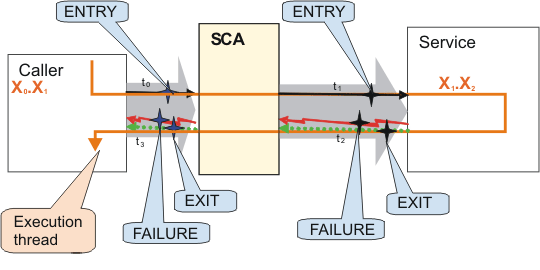IBM BPM, V8.0.1, All platforms > Measuring and improving business processes > Monitoring > Enabling and configuring service component monitoring > Monitoring performance > Application Response Measurement statistics for the Service Component Architecture
Synchronous invocations
You can obtain Application Response Measurement (ARM) performance statistics from a simple SCA call to a service and the response from the service.
Parameters
Event monitoring for SCA components includes the event points that are shown in black  , while the event points shown in blue
, while the event points shown in blue 
In Table 1 and Figure 1, the "current" ARM transaction (denoted as X 1) is created when the calling
service component was invoked for the first time. If the caller is not a service component, the current ARM transaction is used, or a new one is created. If it is not the starting transaction then it has a parent, as represented in the following table and diagram with the notation X n.X n+1. The notation
is used to document the transaction lineage. Every SCA invocation
starts a new transaction, which is parented by the current transaction of the caller. You can create new transactions and you can access the current transaction, but they do not modify the SCA transaction lineage.
Figure 1. ARM statistics obtained from an SCA call with a synchronous implementation
Application Response Measurement statistics for the Service Component Architecture
Statistics
Formula
ARM Transaction
TotalResponseTime
t 3 - t 0
X 0 .X 1
RequestDeliveryTime
t 1 - t 0
X 1 .X 2
ResponseDeliveryTime
t 3 - t 2
GoodRequests
Count EXIT
BadRequests
Count FAILURE
ProcessTime
t 2 - t 1
